Thursday, October 15, 2020 /05:00 AM / by Alex Kimani ofOilprice.com / Header Image Credit: Bloomberg Quint
Afew years back, the fossil fuel sector was doing just fine while renewable andalternative energy investments were considered a wildcard because the sectorwas regarded as unchartered territory. But with the shift to clean energy andthe war against climate change in full swing while fossil fuels continue toface their biggest existential crisis in history, the momentum hasoverwhelmingly shifted to lower carbon fuels. Paris-based InternationalEnergy Agency, IEA, has just released its flagship publication, the World EnergyOutlook 2020, which provides a comprehensive view of how the global energysystem could develop in the coming decades. The organization notes that thisyear's exceptional circumstances require an exceptional approach, meaning theusual long-term modeling horizons have been retained, but the focus for theWorld Energy Outlook 2020 is firmly on the next 10 years, exploring in detailthe impacts of the Covid-19 pandemic on the energy sector, and the near-termactions that could accelerate clean energy transitions.
The report is decidedly bearish for fossil fuel; however, thesilver lining is this: A global economy on the skids will lead to the biggestdrop in CO2 emissions on record with renewables playing an even biggerrole in the electricity generation mix. In fact, the projected 2.4 gigatonnes(Gt) decline in annual CO2 emissions will dial the emissions clock back towhere it was a decade ago.
Otherthan that, the report is mostly negative for the fossil fuel industry, so braceyourself.
Nearly every analyst agrees that the Covid-19 crisis has wroughtmore disruption to the energy sector than any other event in the sector'shistory. What remains debatable is the extent of the damage.
Well, according to the IEA,battered global energy demand is still likely to stage a rebound even in theworst-case scenario, but the extent of that rebound will largely depend on theclimate change policies that the world governments adopt going forward.
The IEA has modeled 4 likelyscenarios for the global energy sector:
- The Stated Policies Scenario (STEPS), is the first one of these wherein Covid-19 is gradually brought under control in 2021, and the global economy returns to pre-crisis levels in the same year. This scenario accommodates the policy intentions and targets that governments have announced so far, backed up by detailed measures for their realization.
- The Delayed Recovery Scenario (DRS) is essentially the same as STEPS, but models a situation whereby a prolonged pandemic causes lasting damage to the global economic prospects. With DRS, the global economy will return to its pre-crisis size only in 2023, meaning energy demand growth over the decade will end up being the lowest since the 1930s.
- In the Sustainable Development Scenario (SDS), renewable energy is likely to enjoy a huge surge thanks to clean energy policies and investment that will place the energy system on track to achieve sustainable energy objectives in full, including the Paris Agreement.
- The new Net Zero Emissions by 2050 case (NZE2050), is essentially an extension of the SDS analysis. In this scenario, many companies and countries target net-zero emissions by around mid-century, putting global emissions on track for net-zero emission by 2070.
Bearing this in mind, here aresome of IEA's interesting findings
1. Pandemic Effects to be Feltfor Decades
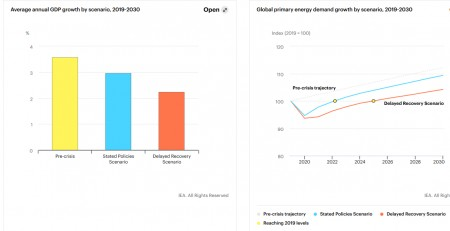
Source: IEA
IEA says that global energydemand is set to drop by 5% in 2020, with energy investment dropping a shocking18%.
But here's the really bad news:In the best-case-scenario (STEP), global energy demand will not fully recoverto pre-Covid-19 levels until 2023.
A slightly worse-case scenario(DRS) delays energy demand recovery by another two years to 2025.
Energy demand growth over thisperiod is 9% in the case of STEPS but only 4% in the DRS. Mind you, the demandgrowth is expected to mostly happen in emerging markets such as India, whilethe advanced economies are likely to continue on a declining trend.
More alarming: Oil and gassectors will bear the brunt of this declining demand, with 2040 production cutby nearly 50% when calculated by present value.
Oil and gas production could becut by half
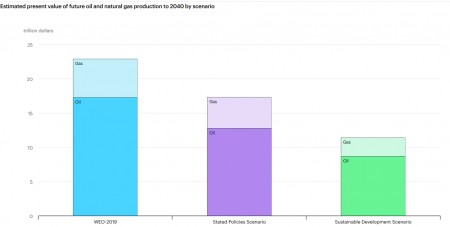
Source: IEA
2. Oil Becomes the Next Tobacco Sector
This is what oil bulls probablydon't want to hear: The oil sector could very much soon face the same fate asthe tobacco sector by entering a phase of terminal decline.
The IEA has reiterated prettymuch what oil bears have been saying: In a not-so-distant universe, renewableenergy is likely to increasingly gain ascendancy while fossil fuels take a backseat.
Even in the best-case scenarios(STEPS and the DRS), oil demand will continue to rise but hit a plateau in the2030s.
The IEA, however, notes that theforecast decline is not cast in stone.
Indeed, the organization saysthat rising incomes in emerging markets and developing economies could create astrong underlying demand for mobility that could possibly offset reductions inoil use in more developed parts of the world.
But at the same time, IEA notesthat transport fuels are no longer a reliable engine for growth. Indeed, fueldemand for passenger cars is likely to peak in both the STEPS and the DRS, dueto improving fuel efficiency as well as robust growth EV sales. Oil use forlonger-distance freight and shipping varies according to the outlook for theglobal economy and international trade.
The petrochemicals sector couldcome to the rescue, with plenty of scope for the demand for plastics to rise,especially in developing economies.
None of this will matter, though,if governments become really aggressive with climate change goals, with oildemand forecast to decline by nearly 35% in a Sustainable Development Scenario.
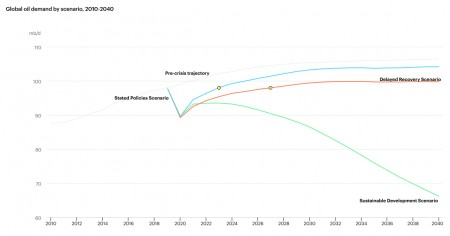
Source: IEA
3. No Reprieve for Coal
If the oil situation is bad, thenthe coal sector is in dire straits.
The IEA says that the coal sectoris forever doomed, with the COVID-19 having catalysed a structural fall inglobal coal demand.
Even in the best-case scenario(STEPS), coal demand will never recover to pre-crisis levels with coal likelyto fall below 20% in our global energy mix by 2040 for the first time since theIndustrial Revolution.
IEAnotes that rampant coal phase-out policies, the rise of renewables, andcompetition from natural gas are likely to lead to the retirement of 275gigawatts (GW) of coal-fired capacity worldwide by 2025 (13% of the 2019total), including 100 GW in the United States alone and another 75 GW in theEuropean Union. Even projected increases in coal demand in developingeconomies, especially in Asia, are likely to be markedly lower and nowhere nearenough to offset falls elsewhere.
4. Natural Gas Fares Better than Other Fossil Fuels
Inpast articles, we have discussed how natural gas has almost universally becomethe renewable energy bridge that is rapidly replacing coal in our electricitygeneration mix thanks mainly to its significantly lower greenhouse gasemissions profile. Natural gas emits about 45% less CO2 than thecleanest coal (sub-bituminous) and 28% less than heating oil for the sameamount of energy produced.
The IEA says natural gas might or might not face a similar fate toother fossil fuels depending on the policies governments adopt.
In STEPS, natural gas could enjoy a 30% rise in demand by 2040thanks mainly to huge demand growth in South and East Asia. At the same time,this is the first time that IEA foresees a decline in gas demand in advancedeconomies over a similar timeframe. Indeed, an uncertain economic recovery islikely to jeopardize the development of LNG export facilities approved inrecent years.
In other words, the natural gas trajectory is very much likely tobe dictated by the climate change targets that governments will set over thenext couple of years.
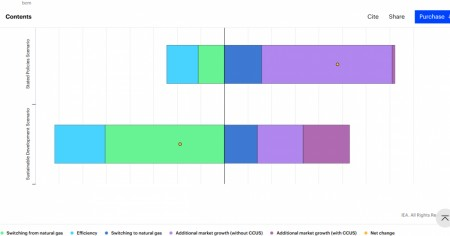
Source: IEA
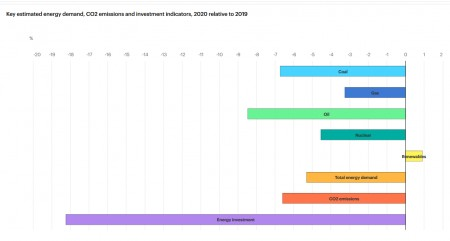
Source: IEA
TheIEA has reported that so far, the renewables sector has proven to be the mostresilient during the ongoing crisis.
Indeed, global use of renewable energy is likely to grow 1.0% Y/Yover the course of the year, mainly due to new wind and solar PV projectscompleted over the past year coming online. Renewables tend to be moreresilient to lower electricity demand than other sources mainly because theyare generally dispatched first due to favorable regulation and/or their loweroperating costs.
While wind energy, especially offshore wind, is likely to continueenjoying robust growth, solar energy is likely to come out on top.
In a STEPS scenario, renewables will meet 80% of the growth inglobal electricity over the next decade. So far, hydropower has remained thelargest renewable source of electricity'. However, the IEA has forecast thatsolar will be the main driver of growth as it sets new records for deploymenteach year after 2022, with onshore and offshore wind taking second andthird place, respectively.
Change in global electricity generation by source andscenario, 2000-2040
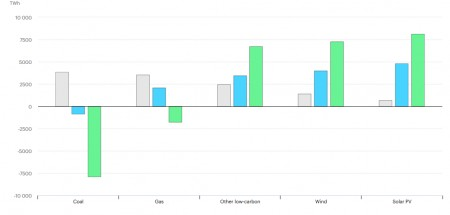
Source: IEA
Credit:
The post 5 Major Takeaways From The IEA'sWorld Energy Outlook 2020 first appearedin Oilprice.com onOctober 14, 2020.
Related News
1. A Pathway toAddressing the Power Sector Challenge - PowerUpNG
2. 33,448,633MWh of Energy Generated in 2019 - NBS
3. The Stifled Nigerian Consumer
4. President Buhari Speaks On New Prices For Petrol,Electricity
5. Sefton Fross to Host Webinar Focused on Improving theResilience of Oil and Gas Firms
6. FAQs On Service-Based Tariff - NERC
7. No Tariff Raise for Poor and Vulnerable Nigerians, NERCDirects DisCos to Embark on Mass Metering
8. CBN Directs DMB-Led Electricity Market Collections
9. Power Generation Sinks After New High
10. Ikeja Electric Launches WhatsApp Chatbot to OptimiseService Delivery, Complaints Resolution
11. Power: Deal with Siemens - The Birth of a New Era?
12. Partial Risk Guarantee Not an Issue in Azura-Edo IPPContract - Presidency
13. Segun Adaju To Speak on Renewable Energy and Nigeria'sEconomic Sustainability
14. Hassana Aliyu To Speak on NESG Framework for ImprovingNigeria's Electricity Supply
15. Power: The Issueof Cost Reflective Tariffs
 Lagos, NG • GMT +1
Lagos, NG • GMT +1











 1366 views
1366 views

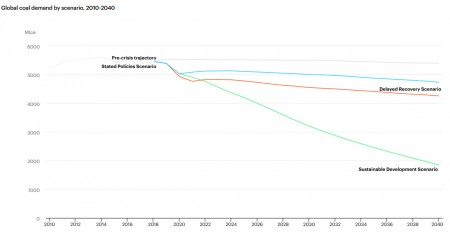









 Sponsored Ad
Sponsored Ad
 Advertise with Us
Advertise with Us









